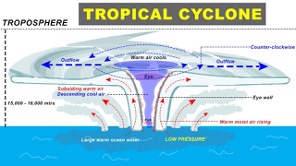Published on: October 27, 2022

Cyclone Sitrang in Bangladesh
Cyclone Sitrang in Bangladesh

Why in news?
A Sitrang cyclone that lashed Bangladesh left about 8 million without power across the delta nation.
Highlights:
- Cyclone Sitrang brewed in the Bay of Bengal before turning north toward Bangladesh’s vast coast, prompting authorities to evacuate hundreds of thousands of people to cyclone shelter
How are cyclones formed?
- Tropical cyclones are formed only over warm ocean waters near the equator.
- When warm, moist air over the ocean rises upward from near the surface, a cyclone is formed.
- When the air rises up and away from the ocean surface, it creates an area of lower air pressure below. It causes the air from surrounding areas with higher pressure to move towards the low-pressure area which further leads to warming up of the air and causes it to rise above.
- As the warm, moist air rises and cools the water in the air forms clouds. The complete system of clouds and wind spins and grows, along with the ocean’s heat and water evaporating from the ocean surface.
- As the wind system rotates with increasing speed, an eye gets formed in the middle. The centre of a cyclone is very calm and clear with very low air pressure. The difference of temperature between the warm, rising and the cooler environment causes the air to rise and become buoyant.
- When the winds speed is 39 mph (63 kmph), the storm is called a “tropical storm”.
- Whereas when the wind speed reaches 74 mph (119 kmph), the storm is officially a “tropical cyclone” or hurricane.

